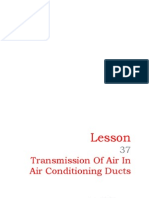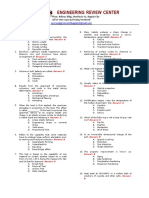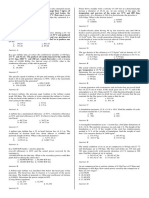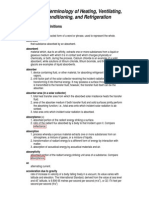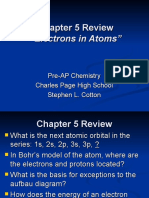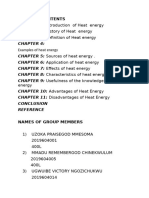0 ratings0% found this document useful (0 votes)
142 viewsExperiment 11-Hvac For Small House
Experiment 11-Hvac For Small House
Uploaded by
engrjayasis20This document provides information about an experiment on heating, ventilating, and air conditioning systems. It discusses the objectives of understanding how to operate an AC system and determine factors affecting it. It then explains the basic refrigeration cycle of an air conditioner, how it works to cool indoor air, and common unit types like window units and split-systems. Finally, it covers different building applications of AC and types of refrigerants used in the cooling process.
Copyright:
© All Rights Reserved
Available Formats
Download as DOCX, PDF, TXT or read online from Scribd
Experiment 11-Hvac For Small House
Experiment 11-Hvac For Small House
Uploaded by
engrjayasis200 ratings0% found this document useful (0 votes)
142 views9 pagesThis document provides information about an experiment on heating, ventilating, and air conditioning systems. It discusses the objectives of understanding how to operate an AC system and determine factors affecting it. It then explains the basic refrigeration cycle of an air conditioner, how it works to cool indoor air, and common unit types like window units and split-systems. Finally, it covers different building applications of AC and types of refrigerants used in the cooling process.
Original Description:
hvac experiment for mechanical laboratory 2
Original Title
Experiment 11-hvac for small house
Copyright
© © All Rights Reserved
Available Formats
DOCX, PDF, TXT or read online from Scribd
Share this document
Did you find this document useful?
Is this content inappropriate?
This document provides information about an experiment on heating, ventilating, and air conditioning systems. It discusses the objectives of understanding how to operate an AC system and determine factors affecting it. It then explains the basic refrigeration cycle of an air conditioner, how it works to cool indoor air, and common unit types like window units and split-systems. Finally, it covers different building applications of AC and types of refrigerants used in the cooling process.
Copyright:
© All Rights Reserved
Available Formats
Download as DOCX, PDF, TXT or read online from Scribd
Download as docx, pdf, or txt
0 ratings0% found this document useful (0 votes)
142 views9 pagesExperiment 11-Hvac For Small House
Experiment 11-Hvac For Small House
Uploaded by
engrjayasis20This document provides information about an experiment on heating, ventilating, and air conditioning systems. It discusses the objectives of understanding how to operate an AC system and determine factors affecting it. It then explains the basic refrigeration cycle of an air conditioner, how it works to cool indoor air, and common unit types like window units and split-systems. Finally, it covers different building applications of AC and types of refrigerants used in the cooling process.
Copyright:
© All Rights Reserved
Available Formats
Download as DOCX, PDF, TXT or read online from Scribd
Download as docx, pdf, or txt
You are on page 1of 9
MAPUA INSTITUTE OF TECHNOLOGY
SCHOOL OF MECHANICAL ENGINEERING
MURALLA ST., INTRAMUROS, MANILA
EXPERIMENT NO. 11
HEATING, VENTILATING, AND AIR CONDITIONING
Bautista, Dave G.
2007103408
Engr. Alberto Suralta
INSTRUCTOR
I. OBJECTIVES
At the end of this experiment, the student will be able to:
1. Operate an A/C system.
2. Determine factors affecting A/C system.
3. Know the heat load
II. THEORY
Air conditioning is the cooling of indoor air for thermal comfort. In a broader sense, the
term can refer to any form of cooling, heating, ventilation, or disinfection that modifies the condition
of air. An air conditioner (often referred to as AC or air con.) is an appliance, system,
or machine designed to stabilize the air temperature and humidity within an area (used for cooling
as well as heating depending on the air properties at a given time), typically using a refrigeration
cycle but sometimes using evaporation, commonly for comfort cooling in buildings and motor
vehicles.
An air conditioner is a device which uses a special type of substance which readily
changes from its normal gas state to a liquid one. The gas is contained in a closed circuit of pipes
connected to a pump. The pump compresses the gas so hard that the pressure is great enough for
it to turn into a liquid. In doing this the gas/liquid has got hot (If you try to compress a gas, it will
almost always get hot - think of a bike pump when you pump up a tyre (tire), the greater the
pressure in the tyre, the hotter the pump gets).
Now the hot liquid travels round a set of pipes which allow the heat to escape. Next the
liquid under pressure passes through a valve into a pipe where the pressure is much lower, and
the liquid evaporate back into its gas state. In doing this it needs to take in heat from its
surroundings, thus making the pipes colder. The gas now gets back to the pump and the whole
cycle starts again.
The pipes are usually arranged so that there are fans to blow air over both the hot part of
the pipes and the cold part. The hot part is frequently put outside the house, and the cold part
inside. This is called either a 'split pack', or a 'twin pack' depending on which country you are in
There are also portable versions which have both parts in the same box, with the cold air blowing
out of the front, and the hot air blowing out of a flexible hose which you put put outside the room to
allow the hot air to dissipate.
Air conditioners use the evaporation of coolants, such as Freon, a nonflammable
fluorocarbon, to create cool air. The evaporation cycle in an air conditioner begins when the
compression unit compresses cool Freon gas. The Freon is mixed with a small amount of oil, which
helps to lubricate the compressor. The compression of the Freon causes it to become a hot, high-
pressured gas.
The gas is then propelled through a series of coils where it dissipates its heat and
condenses into a liquid. Next, the Freon moves through an expansion valve where it becomes a
cold, low-pressured gas. Then, the gas runs through another set of coils that allows the gas to
absorb heat and cool down the air inside your home. Fans placed near these coils help to propel
hot air outside and move cool air inside.
Air conditioning engineers broadly divide air conditioning applications
into comfort and process.
Comfort applications aim to provide a building indoor environment that remains relatively
constant in a range preferred by humans despite changes in external weather conditions or in
internal heat loads.
Air conditioning makes deep plan buildings feasible, for otherwise they'd have to be built
narrower or with light wells so that inner spaces receive sufficient outdoor air via natural ventilation.
Air conditioning also allows buildings to be taller since wind speed increases significantly with
altitude making natural ventilation impractical for very tall buildings. Comfort applications for
various building types are quite different and may be categorized as
Low-Rise Residential buildings, including single family houses, duplexes, and small
apartment buildings
High-Rise Residential buildings, such as tall dormitories and apartment blocks
Commercial buildings, which are built for commerce, including offices, malls, shopping
centers, restaurants, etc.
Institutional buildings, which includes hospitals, governmental, academic, and so on.
Industrial spaces where thermal comfort of workers is desired.
Window and Split-system AC Units
A window air conditioner unit implements a complete air conditioner in a small space. The
units are made small enough to fit into a standard window frame. You close the window down on
the unit, plug it in and turn it on to get cool air. If you take the cover off of an unplugged window
unit, you'll find that it contains:
A compressor
An expansion valve
A hot coil (on the outside)
A chilled coil (on the inside)
Two fans
A control unit
The fans blow air over the coils to improve their ability to dissipate heat (to the outside air)
and cold (to the room being cooled).
When you get into larger air-conditioning applications its time to start looking at split-
system units. A split-system air conditioner splits the hot side from the cold side of the system, as
in the diagram below.
The cold side, consisting of the expansion valve and the cold coil, is generally placed into a
furnace or some other air handler. The air handler blows air through the coil and routes the air
throughout the building using a series of ducts. The hot side, known as the condensing unit, lives
outside the building.
The unit consists of a long, spiral coil shaped like a cylinder. Inside the coil is a fan, to blow
air through the coil, along with a weather-resistant compressor and some control logic. This
approach has evolved over the years because it's low-cost, and also because it normally results in
reduced noise inside the house (at the expense of increased noise outside the house). Other than
the fact that the hot and cold sides are split apart and the capacity is higher (making the coils and
compressor larger), there's no difference between a split-system and a window air conditioner.
In warehouses, large business offices, malls, big department stores and other sizeable
buildings, the condensing unit normally lives on the roof and can be quite massive. Alternatively,
there may be many smaller units on the roof, each attached inside to a small air handler that cools
a specific zone in the building.
In larger buildings and particularly in multi-story buildings, the split-system approach
begins to run into problems. Either running the pipe between the condenser and the air handler
exceeds distance limitations (runs that are too long start to cause lubrication difficulties in the
compressor), or the amount of duct work and the length of ducts becomes unmanageable. At this
point, it's time to think about a chilled-water system.
REFRIGERANTS
Air conditioning has to use refrigerants and although there are many types of refrigerants,
including air and water, it is necessary to use chemicals for reasons of efficiency and ultimately to
conserve energy.
Types of Refrigerants
ODP - The ODP or Ozone Depletion Potential, is the potential for a single molecule of the
refrigerant to destroy the Ozone Layer. All of the refrigerants use R11 as a datum reference and
thus R11 has an ODP of 1.0. The less the value of the ODP the better the refrigerant is for the
ozone layer and therefore the environment.
GWP - The GWP, or Global Warming Potential, is a measurement of how much effect the
given refrigerant will have on Global Warming in relation to Carbon Dioxide, where CO2 has a
GWP of 1. This is usually measured over a 100-year period. In this case the lower the value of
GWP the better the refrigerant is for the environment.
R11 is a single chlorofluorocarbon or CFC compound. It has a high chlorine content and
ozone depletion potential (ODP) and high global warming potential (GWP). The use and
manufacture of R11 and similar CFC refrigerants is now banned within the European Union even
for servicing. - ODP = 1, GWP = 4000
R22 is a single hydro chlorofluorocarbon or HCFC compound. It has low chlorine content
and ozone depletion potential and only a modest global warming potential. R22 can still be used in
small heat pump systems, but no more new systems can be manufactured for use in the EU after
late 2003. From 2010 only recycled or saved stocks of R22 can be used, as it will no longer be
manufactured. - ODP = 0.05, GWP = 1700
R134A is a single hydro fluorocarbon or HFC compound. It has no chlorine content, no
ozone depletion potential, and only a modest global warming potential. - ODP = 0, GWP = 1300
R407C is a ternary blend of hydro fluorocarbon or HFC compounds, comprising 23% of
R32, 25% of R125 and 52% of R134a. It has no chlorine content, no ozone depletion potential, and
only a modest direct global warming potential. - ODP = 0, GWP = 1610
R410A is a binary blend of hydro fluorocarbon or HFC compounds, comprising 50% of
R32 and 50% of R125) it has no chlorine content, no ozone depletion potential, and only a modest
global warming potential. - ODP = 0, GWP 1890
R417A is the zero ODP replacement for R22 suitable for new equipment and as a drop-in
replacement for existing systems.
There are currently no restrictions on equipment or use of the following refrigerants:
R134A, R407C, R410A, and R417A.
Alternative Refrigerants
R290 - Pure propane, a hydrocarbon (HC) an efficient naturally occurring refrigerant with
similar properties to R22, but have no ozone depletion potential and an extremely low global
warming potential. Whilst it is environmentally safe, it is also highly flammable and must only be
used after careful consideration is given to safety. - ODP = 0, GWP = 3.
Ammonia - A highly efficient refrigerant, which has been used in industrial applications for
many years and with success. It is however; highly toxic and very careful consideration must be
given to any design or application.
III. LIST OF APPARATUS
1. AMATROL T7082
2. AMATROL T7083
3. ANEMOMETER
IV. PROCEDURE
Modify the air movement components on a thermal system and evaluate the change in the
air flow path.
Option 1: Open all ducts, maximum heat load
Option 2: Open all ducts, minimum heat load
Option 3: Open supply ducts, 25% return air, maximum heat load
How to turn on the Air Conditioning System (Cooling Mode)
Step 1: Open the turn on button
Step 2: Set to F for the Fahrenheit unit
Step 3: Press Set and select 55
O
F
Step 4: Press Set and select -10
Step 5: Press Set and select C1 for Cooling Mode
Skills:
1. Close the ventilation without attic insulation, open all heat load, open all ducts.
Heat Loads:
Bright Light
Attic Heater
Ceiling Fan
Attic Fan
2. Open ventilation with attic insulation, off all loads
3. Open heat loads, close ventilation with attic insulation, 25% return air
V. SET UP OF APPARATUS
VI. DISCUSSION
This experiment is all about the air conditioning system. Here, the students were able to
see the process of a thermal system and how it works. The students discussed the process of
heating and cooling of the thermal system individually. The parts of the thermal system were
also discussed.
VII. CONCLUSION
After the experiment that we have done, I can say that we were able to operate an A/C
system. We were able to have the knowledge about its basic component, function, operation
and its application. Factors affecting the A/C system were also determined. Lastly, we were
able to the heat load of the refrigerant 134A.
VIII. QUESTIONS AND ANSWERS
1. What is a refrigerant?
A refrigerant is a substance used in a heat cycle usually including, for enhanced
efficiency, a reversible phase change from a gas to a liquid.
2. What is Air Conditioning?
It controls the properties of air so that the air will be suitable for its intended use.
3. What are the functions of Air Conditioning?
Control the temperature
Control the humidity
Control the purity, that is, removal of dust and other impurities
Control of air movement or circulation
IX. PROBLEMS AND SOLUTIONS
1. A room being air conditioned is being held at 25C dry bulb and 50% relative humidity.
A flow rate of 5 m
3
/s of supply air at 15C dry bulb and 80% relative humidity is being
delivered to the room to maintain that steady condition. What is the sensible heat
absorbed from the room air in kw?
Solution:
PV = mRT
100(5) = m(0.287)(15 + 273)
m = 6.049 kg/s
Qs = sensible heat
= mCp(t2 t1)
= 6.049(1.003)(25-15) = 60.8 kW
2. What is the enthalpy of the air vapor mixture at 65% relative humidity and 34C
when the barometric pressure is 101.3 kPa?
Given:
Psat at 34C = 5.318 kPa
hg at 34C = 2563.6 kJ/kg
Solution:
Pv = RH x Psat
= 0.65 x 5.318 = 3.4567 kPa
W = 0.622
= 0.622 (
) = 0.022 kg/kg
h = Cpt + Whg
= 1.0(34) + 0.022(2563.6)
= 90.4 kJ/kg
3. A mechanical draft dry cooling tower cools the cooling water from 60C to 25C at the
rate of some 149.4 giga grams per hour. Atmospheric air enters the tower at 20C and
leaves at 35C. The fan is driven by a 7460 kw motor. What is the mass flow rate of
the air into the cooling water in kg per second?
Solution:
mw =
= 41, 500 kg/s
heat loss by water = heat gain by air
(mCpt)water = (mCpt)air
41,500(4.187)(60-25) = ma(1.006)(35-20)
ms = 403, 023 kg/s
X. REFERENCES
http://en.wikipedia.org/wiki/Refrigerant
Mechanical Engineering Formulas 2
nd
Edition, by Jas Tordillo
You might also like
- Meneses, Keziah F.: Cop T T T T T T Where: T T T Cop COP 1.4696 1.47Document19 pagesMeneses, Keziah F.: Cop T T T T T T Where: T T T Cop COP 1.4696 1.47Eriane GarciaNo ratings yet
- Physics Chapt 19Document84 pagesPhysics Chapt 19catlinmwagner0% (1)
- Assignment 2Document2 pagesAssignment 2Venkitaraj K PNo ratings yet
- Module 5: Precipitation, Denaturation and Coagulation: Name: Group No.: 6Document7 pagesModule 5: Precipitation, Denaturation and Coagulation: Name: Group No.: 6Ma. Lara Micaela Legaspi100% (1)
- Region 7Document18 pagesRegion 7Dareen CuetoNo ratings yet
- Machine Design Trial 1Document13 pagesMachine Design Trial 1JerdNo ratings yet
- Cooling Tower Lab ReportDocument20 pagesCooling Tower Lab Reportgodfrey100% (1)
- Basic Engineering Correlation Algebra ReDocument78 pagesBasic Engineering Correlation Algebra Redavid ursulaNo ratings yet
- PIPE ProblemsDocument7 pagesPIPE ProblemsEarl James RoqueNo ratings yet
- PipeDocument8 pagesPipeJohn Paulo BuzonNo ratings yet
- Aircon LabDocument16 pagesAircon LabMILTON SALINASNo ratings yet
- Pipe Problems Looks Fam 2Document178 pagesPipe Problems Looks Fam 2Eep Jay0% (1)
- C16 Pumps AlcorconDocument32 pagesC16 Pumps AlcorconAdrian S. Pascual100% (1)
- Dryers CompressDocument9 pagesDryers CompressJohn A. CenizaNo ratings yet
- PIPE Reviewer LooksfamDocument15 pagesPIPE Reviewer LooksfamRichelle Valerie Bastro100% (1)
- VIP 5 Powerplant ExamDocument7 pagesVIP 5 Powerplant ExamJaybee LabraNo ratings yet
- Otto CycleDocument4 pagesOtto CycleRaven MercadoNo ratings yet
- Coaching Problems CFDocument5 pagesCoaching Problems CFDeyn EstoqueNo ratings yet
- Refrigeration Paper in IJSER FormatDocument14 pagesRefrigeration Paper in IJSER Formattitto84886No ratings yet
- Coaching Modus2Document17 pagesCoaching Modus2Manoy BermeoNo ratings yet
- Pipe-Prc, Evaluating - #2013-2930-0329aDocument11 pagesPipe-Prc, Evaluating - #2013-2930-0329aStephanie Park0% (1)
- Ideal Gas Examples Part 4.3Document8 pagesIdeal Gas Examples Part 4.3asapamoreNo ratings yet
- Ppe Problem Set - Diesel - EngineDocument5 pagesPpe Problem Set - Diesel - EngineMichael Jason JanduganNo ratings yet
- IPE Exit Exam Reviewer (BB)Document41 pagesIPE Exit Exam Reviewer (BB)ChesterJerichoRamosNo ratings yet
- Power and Industrial Plant Engineering 1Document7 pagesPower and Industrial Plant Engineering 1Ella Grace GalangNo ratings yet
- Wdghwahdg PDFDocument2 pagesWdghwahdg PDFKim Howard CastilloNo ratings yet
- Law and Code of EthicsDocument53 pagesLaw and Code of EthicsKenn Earl Bringino VillanuevaNo ratings yet
- Pang Malakasang Pipe RefresherDocument478 pagesPang Malakasang Pipe Refresheraljay balingitNo ratings yet
- Batangas State UniversityDocument12 pagesBatangas State UniversityRaneljohn GondaNo ratings yet
- R&AC Lecture 40Document13 pagesR&AC Lecture 40Mohammed SiddiqueNo ratings yet
- Me Lab 7Document4 pagesMe Lab 7BensoyNo ratings yet
- InDocument17 pagesInVon A. DamirezNo ratings yet
- Transmission of Air in Air Conditioning Ducts: LessonDocument18 pagesTransmission of Air in Air Conditioning Ducts: Lessoncaptainhass100% (1)
- Preboards 2-PipeDocument4 pagesPreboards 2-PipeBenedictVillaminPolicarpioNo ratings yet
- MDSP ElementsDocument71 pagesMDSP ElementsFernan MacusiNo ratings yet
- Preboards 3-PipeDocument4 pagesPreboards 3-PipeChyno KangNo ratings yet
- Meng Ass 2Document2 pagesMeng Ass 2sutha_me200982820% (1)
- Refresher No.5 (MDSP)Document4 pagesRefresher No.5 (MDSP)chyno.kang08No ratings yet
- Problem Set MD Day 6Document5 pagesProblem Set MD Day 6WIIGEENNo ratings yet
- Power and Industrial Plant EngineeringDocument84 pagesPower and Industrial Plant EngineeringPrince PastorałNo ratings yet
- Cit - University Mechanical Engineering Me Comprehensive Evaluation Course 3Document2 pagesCit - University Mechanical Engineering Me Comprehensive Evaluation Course 3Kurt BaylanNo ratings yet
- Diesel Power Plant Design Page 1Document1 pageDiesel Power Plant Design Page 1Roland LewisNo ratings yet
- Applied Mechanical Engineering (Basic Thermo) I. Problem SolvingDocument4 pagesApplied Mechanical Engineering (Basic Thermo) I. Problem SolvingasapamoreNo ratings yet
- Pipe Set 1Document10 pagesPipe Set 1RENE JOSHUA PECASONo ratings yet
- MESL - Plane and Solid GeometryDocument8 pagesMESL - Plane and Solid GeometryMark-Lorie Duculan NonesNo ratings yet
- Thermo 1-Problem Set Part 2Document5 pagesThermo 1-Problem Set Part 2Elisif DeFairNo ratings yet
- Pipe Looksfam Coaching DiscussionDocument32 pagesPipe Looksfam Coaching DiscussionManoy BermeoNo ratings yet
- Mathfinal Refresh. 1Document1 pageMathfinal Refresh. 1Francis AlmiaNo ratings yet
- Student - S Trivia Exam 2Document6 pagesStudent - S Trivia Exam 2Marcial Militante100% (1)
- PP Chapter 6 Air Conditioning ShowDocument59 pagesPP Chapter 6 Air Conditioning ShowRashiqah RazlanNo ratings yet
- Solution Machine DesignDocument9 pagesSolution Machine DesignRheymar MercadoNo ratings yet
- T-MEET324LA Experiment No.9 Cloud and Pour Point Tests Group5 MEE31Document10 pagesT-MEET324LA Experiment No.9 Cloud and Pour Point Tests Group5 MEE31Paul Ryan GeneralNo ratings yet
- CHAPTER 10 Cooling Load January 2012Document50 pagesCHAPTER 10 Cooling Load January 2012Franky FlamNo ratings yet
- Handouts PPE Day 10Document6 pagesHandouts PPE Day 10MaribethCanesoMappeNo ratings yet
- Quiz 1 - AlgebraDocument7 pagesQuiz 1 - AlgebrapauljpameNo ratings yet
- Air ConditioningDocument5 pagesAir ConditioningDC1234No ratings yet
- ECM216 BUILDING SERVICES Bab 2.2 Air ConditioningDocument8 pagesECM216 BUILDING SERVICES Bab 2.2 Air ConditioningAZUAN BIN AHMAD FAUZI75% (4)
- Mapua Institute of Technolog1Document15 pagesMapua Institute of Technolog1Ian KasaiNo ratings yet
- Introduction Air ConditionersDocument5 pagesIntroduction Air Conditionersbentarigan77No ratings yet
- On Air ConditioningDocument26 pagesOn Air ConditioningTej KalyanNo ratings yet
- Air Conditioning BasicsDocument47 pagesAir Conditioning BasicsVIJUKUMARNo ratings yet
- Ice Manufacturing: A. Can SystemDocument3 pagesIce Manufacturing: A. Can Systemengrjayasis20No ratings yet
- ME150P ELecture 1 (04 January 2011)Document115 pagesME150P ELecture 1 (04 January 2011)engrjayasis200% (1)
- Airconditioning System ApplicationDocument6 pagesAirconditioning System Applicationengrjayasis20No ratings yet
- Aircon Jive Part 3 of Chapter 15Document14 pagesAircon Jive Part 3 of Chapter 15engrjayasis20No ratings yet
- HvacDocument249 pagesHvacengrjayasis20No ratings yet
- Module 6: Reaction Kinetics and Dynamics Lecture 27: Experimental Methods in Chemical KineticsDocument6 pagesModule 6: Reaction Kinetics and Dynamics Lecture 27: Experimental Methods in Chemical KineticsHamit RanaNo ratings yet
- Chapter 5 ReviewDocument13 pagesChapter 5 ReviewHdh DhdhNo ratings yet
- Ekalavya Revision Plan - Deeksha-2023-2024Document4 pagesEkalavya Revision Plan - Deeksha-2023-2024Max KaleNo ratings yet
- Science Class X Term II Reference Study MaterialDocument222 pagesScience Class X Term II Reference Study MaterialMohamed TahmeedNo ratings yet
- Atoms, Molecules and IonsDocument28 pagesAtoms, Molecules and Ionsgamaan cNo ratings yet
- Cross-Linking Organic Coating With BlockedDocument6 pagesCross-Linking Organic Coating With Blockedalfi alfathanaNo ratings yet
- 2021-22 Sem II Insem Exam Question Bank-1Document3 pages2021-22 Sem II Insem Exam Question Bank-1ratnesh sanklechaNo ratings yet
- Sed 241-1Document19 pagesSed 241-1chidoziematthew58No ratings yet
- Arrhenius EquationDocument5 pagesArrhenius EquationSham SajaNo ratings yet
- Structure Bonding and The Properties of Matter FoundationDocument12 pagesStructure Bonding and The Properties of Matter FoundationSafaa AkramNo ratings yet
- Part 6 General EducationDocument10 pagesPart 6 General Educationrodel villenaNo ratings yet
- Danfoss Retrofit and High Glide RefrigerantsDocument14 pagesDanfoss Retrofit and High Glide RefrigerantsIEA.BOD.I2 - Sơn, Vũ Văn - Giám đốc E&A - INTECH GROUPNo ratings yet
- JAMB Chemistry Past Question 1983 2004Document119 pagesJAMB Chemistry Past Question 1983 2004iamprecious2allNo ratings yet
- Trunnion & Shoe Temp. Calculation.Document27 pagesTrunnion & Shoe Temp. Calculation.Bharat Bellad100% (1)
- Corrosion Preventive Materials and Corrosion TestiDocument96 pagesCorrosion Preventive Materials and Corrosion Testiนรวิชญ์ กาญจนามัยNo ratings yet
- 188 - Biochemistry Physiology) Michaelis Menten EquationDocument4 pages188 - Biochemistry Physiology) Michaelis Menten EquationSairamNo ratings yet
- Wave Guide DispersionDocument3 pagesWave Guide DispersionSriraj ChinnaNo ratings yet
- Week 5 & 6Document10 pagesWeek 5 & 6Mariel MirafloresNo ratings yet
- Module 4 - Boiler Accessories, Super HeaterDocument74 pagesModule 4 - Boiler Accessories, Super Heaterkngkng100% (1)
- Itmti Chemistry Term 2 STPM Chapter 7 Chemical EnergeticsDocument47 pagesItmti Chemistry Term 2 STPM Chapter 7 Chemical EnergeticsCherry T CYNo ratings yet
- Ionic Covalent LABDocument3 pagesIonic Covalent LABPriyasree KarunanethiNo ratings yet
- Spectrophotometric Determination of Iron in Natural Water (Experiment 13)Document5 pagesSpectrophotometric Determination of Iron in Natural Water (Experiment 13)Caleb JalmascoNo ratings yet
- Quantum Physics For Beginners - Steven N. FulmerDocument123 pagesQuantum Physics For Beginners - Steven N. FulmerRon FarnsworthNo ratings yet
- Lecture34 Wed Dec 6Document3 pagesLecture34 Wed Dec 6Akib ImtihanNo ratings yet
- Actividad 5 TermodinamicaDocument4 pagesActividad 5 TermodinamicaAngel EncastinNo ratings yet
- Xii Iit RPTM - 16 Q.paper (17.12.22)Document13 pagesXii Iit RPTM - 16 Q.paper (17.12.22)Dinesh BabuNo ratings yet
- Weekly Study Plan Grade: 9 DATE: 08/09/2024 - 12/09/2024Document2 pagesWeekly Study Plan Grade: 9 DATE: 08/09/2024 - 12/09/2024mahmoud3790.maNo ratings yet
- Solvent Exchange On Metal Ions: Advances in Inorganic Chemistry VOLUME 54 ISSN 0898 - 8838 All Rights ReservedDocument69 pagesSolvent Exchange On Metal Ions: Advances in Inorganic Chemistry VOLUME 54 ISSN 0898 - 8838 All Rights Reservedgeo angNo ratings yet
































